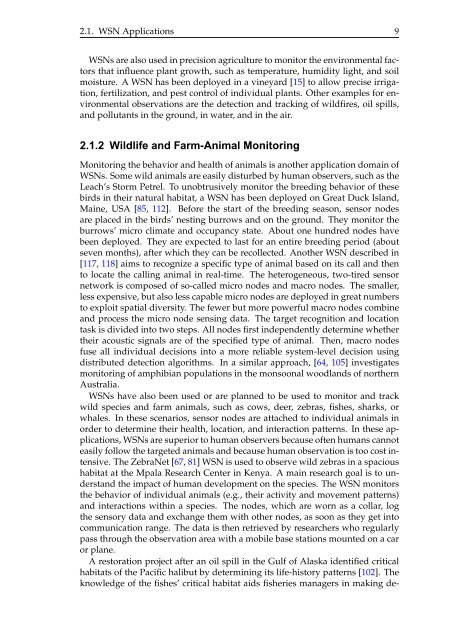A State-Based Programming Model for Wireless Sensor Networks
A State-Based Programming Model for Wireless Sensor Networks
A State-Based Programming Model for Wireless Sensor Networks
Create successful ePaper yourself
Turn your PDF publications into a flip-book with our unique Google optimized e-Paper software.
2.1. WSN Applications 9<br />
WSNs are also used in precision agriculture to monitor the environmental factors<br />
that influence plant growth, such as temperature, humidity light, and soil<br />
moisture. A WSN has been deployed in a vineyard [15] to allow precise irrigation,<br />
fertilization, and pest control of individual plants. Other examples <strong>for</strong> environmental<br />
observations are the detection and tracking of wildfires, oil spills,<br />
and pollutants in the ground, in water, and in the air.<br />
2.1.2 Wildlife and Farm-Animal Monitoring<br />
Monitoring the behavior and health of animals is another application domain of<br />
WSNs. Some wild animals are easily disturbed by human observers, such as the<br />
Leach’s Storm Petrel. To unobtrusively monitor the breeding behavior of these<br />
birds in their natural habitat, a WSN has been deployed on Great Duck Island,<br />
Maine, USA [85, 112]. Be<strong>for</strong>e the start of the breeding season, sensor nodes<br />
are placed in the birds’ nesting burrows and on the ground. They monitor the<br />
burrows’ micro climate and occupancy state. About one hundred nodes have<br />
been deployed. They are expected to last <strong>for</strong> an entire breeding period (about<br />
seven months), after which they can be recollected. Another WSN described in<br />
[117, 118] aims to recognize a specific type of animal based on its call and then<br />
to locate the calling animal in real-time. The heterogeneous, two-tired sensor<br />
network is composed of so-called micro nodes and macro nodes. The smaller,<br />
less expensive, but also less capable micro nodes are deployed in great numbers<br />
to exploit spatial diversity. The fewer but more powerful macro nodes combine<br />
and process the micro node sensing data. The target recognition and location<br />
task is divided into two steps. All nodes first independently determine whether<br />
their acoustic signals are of the specified type of animal. Then, macro nodes<br />
fuse all individual decisions into a more reliable system-level decision using<br />
distributed detection algorithms. In a similar approach, [64, 105] investigates<br />
monitoring of amphibian populations in the monsoonal woodlands of northern<br />
Australia.<br />
WSNs have also been used or are planned to be used to monitor and track<br />
wild species and farm animals, such as cows, deer, zebras, fishes, sharks, or<br />
whales. In these scenarios, sensor nodes are attached to individual animals in<br />
order to determine their health, location, and interaction patterns. In these applications,<br />
WSNs are superior to human observers because often humans cannot<br />
easily follow the targeted animals and because human observation is too cost intensive.<br />
The ZebraNet [67, 81] WSN is used to observe wild zebras in a spacious<br />
habitat at the Mpala Research Center in Kenya. A main research goal is to understand<br />
the impact of human development on the species. The WSN monitors<br />
the behavior of individual animals (e.g., their activity and movement patterns)<br />
and interactions within a species. The nodes, which are worn as a collar, log<br />
the sensory data and exchange them with other nodes, as soon as they get into<br />
communication range. The data is then retrieved by researchers who regularly<br />
pass through the observation area with a mobile base stations mounted on a car<br />
or plane.<br />
A restoration project after an oil spill in the Gulf of Alaska identified critical<br />
habitats of the Pacific halibut by determining its life-history patterns [102]. The<br />
knowledge of the fishes’ critical habitat aids fisheries managers in making de-
















